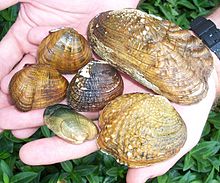| Ambleminae Temporal range: | |
|---|---|
 | |
| Bottom diagonal row, left to right: Epioblasma brevidens , Epioblasma capsaeformis Middle row: Fusconaia cor , Lemiox rimosus , Quadrula intermedia Top row: Quadrula cylindrica | |
| Scientific classification | |
| Domain: | Eukaryota |
| Kingdom: | Animalia |
| Phylum: | Mollusca |
| Class: | Bivalvia |
| Order: | Unionida |
| Family: | Unionidae |
| Subfamily: | Ambleminae Rafinesque, 1820 |
| Genera | |
See text | |
Ambleminae is a subfamily of freshwater mussel in the family Unionidae. They are found throughout much of eastern North America south to Central America, although fossils are also known from Siberia. Some species have also been introduced to East Asia. They are the most speciose radiation of the Unionidae, with more than 300 species. [1] [2]
Fossils of this group date back to the Late Cretaceous. [3]